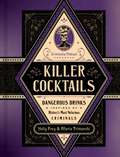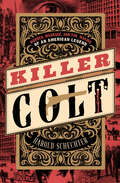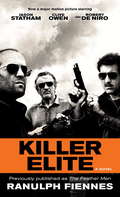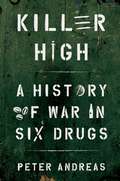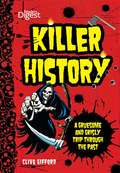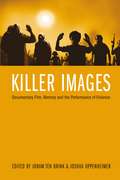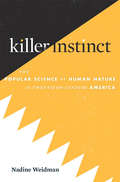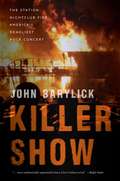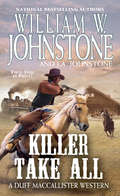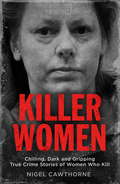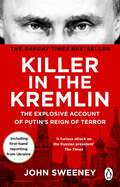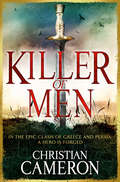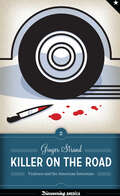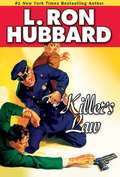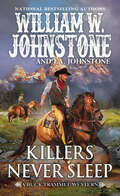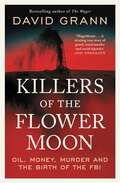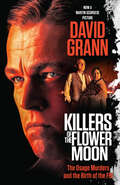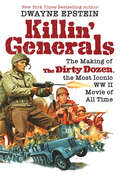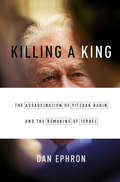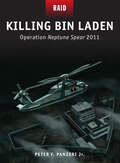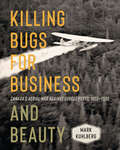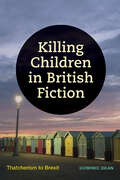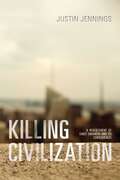- Table View
- List View
Killer Cocktails: Dangerous Drinks Inspired by History's Most Nefarious Criminals
by Maria Trimarchi Holly FreyFrom the hosts of the criminally popular podcast Criminalia, Holly Frey and Maria Trimarchi, a dangerously delicious cocktail and mocktail book inspired by history&’s most notorious (and notoriously overlooked) criminals Every month, over 200,000 listeners download Criminalia to hear stories of history&’s wildest and most devious criminals they never knew existed. But this isn't just any true-crime podcast—more than an engaging history lesson, Criminalia also offers a cocktail recipe to go with each criminal. After all, what pairs better with the story of an identity-shifting murderess who burned her house down to cover up a crime… than a fiery jalapeño cocktail? In KILLER COCKTAILS, Criminalia cohosts Holly Frey and Maria Trimarchi offer readers a cornucopia of creative and out-of-the-box cocktail and mocktail recipes, inspired by some of the wildest, weirdest, and most bizarre crimes throughout history. Written with their signature wit and humor, KILLER COCKTAILS gives us dozens of recipes, many of which fans have never seen before, expertly paired with its historical dastardly villain. From brutish bodysnatchers and comely conwomen, to poisonous chemists, nefarious mystics, and even a pirate queen, this book is perfect for anyone who loves a juicy, bloody story and a creative concoction. History and true crime lovers, cocktail and mocktail enthusiasts, and anyone looking for the perfect gift for their off-beat friend will find much to savor in this wickedly fun book. Brimming with stranger-than-fiction stories and recipes that are equally thought-provoking and tasty, KILLER COCKTAILS is a double-shot of morbid fun—and will satisfy all your darkest cravings for years to come.
Killer Colt: Murder, Disgrace, and the Making of an American Legend
by Harold SchechterAn in-the-room account of John Colt&’s scandalous nineteenth-century murder trial from &“America&’s principal chronicler of its greatest psychopathic killers&” (Boston Review). In this masterful account, renowned true-crime historian Harold Schechter takes you into the life and crimes of convicted murderer John Caldwell Colt, drawing parallels between John&’s rise to notoriety and his brother Samuel Colt&’s rise to fame as the inventor of the legendary revolver. With a killing that made headlines around the nation, John Colt became a cultural touchstone whose shocking villainy inspired and provoked such writers as Edgar Allan Poe, Walt Whitman, and Herman Melville. Unlike his brother, John lived a nomadic existence, bouncing from one job to another. His one distinction, writing a reference accounting book, would play a part in his fall from grace. For in New York City, on September 17, 1841, John murdered printer Samuel Adams with a hatchet during a heated argument over proceeds from book sales. A media circus ensued, galvanizing the penny press, which printed lurid headlines and gruesome woodcut illustrations. The standing-room-only trial created unforgettable moments in legal history, including such dramatic evidence as Samuel Adams&’s decomposed head. The verdict and its aftermath would reverberate throughout the country and beyond, giving John Colt lasting infamy. &“[Schechter] leads us through Colt&’s trial with such precision that you can smell the cigar smoke in the courtroom. . . . Killer Colt succeeds in making us care about this story now by showing why it mattered to so many people then.&” —HistoryNet
Killer Elite (Previously Published as The Feather Men)
by Ranulph FiennesThe "enthralling page-turner" (Library Journal) now a major motion picture starring Jason Statham, Clive Owen, and Robert De Niro. Here is a gripping novel, inspired by real-life events, about a private team of British vigilantes that sets out to eliminate a gang of cold-blooded contract killers. From 1977 to 1990, four former British soldiers die, one by one, supposedly due to accident or illness. But soon a link is established between the victims: a shared mission in the desert kingdom of Oman, where they fought for a sultan against insurgents and ruined the life of a rival sheikh, who in turn has sent a band of assassins to methodically slay the soldiers and salvage his pride. Now these clever assassins are on the run from an underground group of SAS vets with nothing to lose, no time to waste, and a desire to dispense their own form of justice--no matter the cost. Previously published as The Feather Men.
Killer High: A History of War in Six Drugs
by Peter AndreasThere is growing alarm over how drugs empower terrorists, insurgents, militias, and gangs. But by looking back not just years and decades but centuries, Peter Andreas reveals that the drugs-conflict nexus is actually an old story, and that powerful states have been its biggest beneficiaries. In his path-breaking Killer High, Andreas shows how six psychoactive drugs-ranging from old to relatively new, mild to potent, licit to illicit, natural to synthetic-have proven to be particularly important war ingredients. This sweeping history tells the story of war from antiquity to the modern age through the lens of alcohol, tobacco, caffeine, opium, amphetamines, and cocaine. Beer and wine drenched ancient and medieval battlefields, and the distilling revolution lubricated the conquest and ethnic cleansing of the New World. Tobacco became globalized through soldiering, with soldiers hooked on smoking and governments hooked on taxing it. Caffeine and opium fueled imperial expansion and warfare. The commercialization of amphetamines in the twentieth century energized soldiers to fight harder, longer, and faster, while cocaine stimulated an increasingly militarized drug war that produced casualty numbers surpassing most civil wars. As Andreas demonstrates, armed conflict has become progressively more drugged with the introduction, mass production, and global spread of mind-altering substances. As a result, we cannot understand the history of war without including drugs, and we similarly cannot understand the history of drugs without including war. From ancient brews and battles to meth and modern warfare, drugs and war have grown up together and become addicted to each other.
Killer History
by Clive GiffordSome kids are natural bookworms and others you have to chase down with a book. But every kid, even the ones that scowl when you say "read" will devour this mega mix of history's grisly stories. From all corners of the globe and dating back to ancient Egypt, this book leaves no tombstone unturned to deliver a glimpse at some of the weirdest traditions, most gruesome methods, craziest causes, and most fascinating facts surrounding death in history. Kids will discover: The ancient Egyptians didn't mummify and bury their dead alone. Oh, no. They also entombed cats, dogs, hippos, crocodiles, and even beetles with their dearly departed. As queen, Marie-Antoinette lost her head for all the fine things France had to offer, and she delighted in them as the country grew poorer and poorer. When the revolution came, she literally lost her head for her frivolity. The guillotine was used for almost 200 years in France. It was the cutting edge of death technology when it was invented in 1792 and stayed in style until 1977. History's most surprising murder weapons The top-ten potent poisons The worst epidemics in history
Killer Images: Documentary Film, Memory, and the Performance of Violence (Nonfictions)
by Joshua Ten Brink Joram OppenheimerCinema has long shaped not only how mass violence is perceived but also how it is performed. Today, when media coverage is central to the execution of terror campaigns and news anchormen serve as embedded journalists, a critical understanding of how the moving image is implicated in the imaginations and actions of perpetrators and survivors of violence is all the more urgent. If the cinematic image and mass violence are among the defining features of modernity, the former is significantly implicated in the latter, and the nature of this implication is the book's central focus. This book brings together a range of newly commissioned essays and interviews from the world's leading academics and documentary filmmakers, including Ben Anderson, Errol Morris, Harun Farocki, Rithy Phan, Avi Mograbi, Brian Winston, and Michael Chanan. Contributors explore such topics as the tension between remembrance and performance, the function of moving images in the execution of political violence, and nonfiction filmmaking methods that facilitate communities of survivors to respond to, recover, and redeem a history that sought to physically and symbolically annihilate them
Killer Instinct: The Popular Science of Human Nature in Twentieth-Century America
by Nadine WeidmanA historian of science examines key public debates about the fundamental nature of humans to ask why a polarized discourse about nature versus nurture became so entrenched in the popular sciences of animal and human behavior. Are humans innately aggressive or innately cooperative? In the 1960s, bestselling books enthralled American readers with the startling claim that humans possessed an instinct for violence inherited from primate ancestors. Critics responded that humans were inherently loving and altruistic. The resulting debate—fiercely contested and highly public—left a lasting impression on the popular science discourse surrounding what it means to be human. Killer Instinct traces how Konrad Lorenz, Robert Ardrey, and their followers drew on the sciences of animal behavior and paleoanthropology to argue that the aggression instinct drove human evolutionary progress. Their message, spread throughout popular media, brought pointed ripostes. Led by the anthropologist Ashley Montagu, opponents presented a rival vision of human nature, equally based in biological evidence, that humans possessed inborn drives toward love and cooperation. Over the course of the debate, however, each side accused the other of holding an extremist position: that behavior was either determined entirely by genes or shaped solely by environment. Nadine Weidman shows that what started as a dispute over the innate tendencies of animals and humans transformed into an opposition between nature and nurture. This polarized formulation proved powerful. When E. O. Wilson introduced his sociobiology in 1975, he tried to rise above the oppositional terms of the aggression debate. But the controversy over Wilson’s work—led by critics like the feminist biologist Ruth Hubbard—was ultimately absorbed back into the nature-versus-nurture formulation. Killer Instinct explores what happens and what gets lost when polemics dominate discussions of the science of human nature.
Killer Show: The Station Nightclub Fire, America's Deadliest Rock Concert
by John BarylickOn February 20, 2003, the deadliest rock concert in U.S. history took place at a roadhouse called The Station in West Warwick, Rhode Island. That night, in the few minutes it takes to play a hard-rock standard, the fate of many of the unsuspecting nightclub patrons was determined with awful certainty. The blaze was ignited when pyrotechnics set off by Great White, a 1980s heavy-metal band, lit flammable polyurethane “egg crate” foam sound insulation on the club’s walls. In less than 10 minutes, 96 people were dead and 200 more were injured, many catastrophically. The final death toll topped out, three months later, at the eerily unlikely round number of 100. The story of the fire, its causes, and its legal and human aftermath is one of lives put at risk by petty economic decisions―by a band, club owners, promoters, building inspectors, and product manufacturers. Any one of those decisions, made differently, might have averted the tragedy. Together, however, they reached a fatal critical mass. Killer Show is the first comprehensive exploration of the chain of events leading up to the fire, the conflagration itself, and the painstaking search for evidence to hold the guilty to account and obtain justice for the victims. Anyone who has entered an entertainment venue and wondered, “Could I get out of here in a hurry?” will identify with concertgoers at The Station. Fans of disaster nonfiction and forensic thrillers will find ample elements of both genres in Killer Show.
Killer Take All (A Duff MacCallister Western #10)
by William W. Johnstone J.A. JohnstoneJohnstone Country. A Home Worth Fighting For.Scotsman-turned-cowboy Duff MacCallister traveled far and worked hard to start a new life in America. And anyone who tries to mess with his dream is in for some serious Highland justice . . . KILLER TAKE ALL The cattle town of Chugwater may not look like much to outsiders. But for Duff MacCallister and the determined settlers who’ve staked their futures here, it’s a land of opportunity. That’s why the whole town is fired up by the latest news. Young railroad developer Jacob Freemantle wants to run a rail line through Chugwater, making it easier to transport cattle. Everyone is on board with the plan—at first. Duff begins to suspect that Freemantle is only after the most valuable land, and he’s using strongarm tactics to force reluctant ranchers to sell. Things only get worse when Freemantle’s hired guns show up—and the violence really begins . . .But Duff’s got a plan of his own. With a little help from some well-armed friends, he’s going to flush this phony out of Chugwater—and run his hired killers out of town on a rail . . .Live Free. Read Hard.
Killer Women: Chilling, Dark and Gripping True Crime Stories of Women Who Kill
by Nigel CawthorneThe Chilling Inside Story of Women Who Are Driven to Kill Killer Women are the most disturbing yet compelling of all criminals, representing the very darkest side of humanity and subverting the conventional view of women as the weaker sex. From Elizabeth Bathory, 'The Bloody Countess' whose vampire-like tendencies terrorised sixteenth-century Hungary, to the Moors Murderer Myra Hindley and the Florida Highway Killer Aileen Wuornos, these women transfix us with their extreme ability to commit savage acts of cruelty and depravity. Most chilling is the fact that many of their victims represent the most vulnerable in society: babies, the ill and infirm, and the elderly. In some cases their methods of disposing of the corpses fall nothing short of ingenious: meet Leonarda Cianciulli, 'The Soap-Maker of Correggio', who used the fat from her victims' bodies to make soap and teacakes to sell to unsuspecting customers. These killers' backgrounds, methods and their crimes are described in forensic and gripping detail.50 terrifying cases of killer women are brought to life, including:Elizabeth Bathory 'The Bloody Countess'Amelia Dyer, The Reading Baby FarmerJane Toppan, 'Jolly Jane'Juana Barraza, The Old Lady KillerLeonarda Cianciulli, 'The Soap-Maker of Correggio'Bonnie Parker, 'Bonnie & Clyde'Rosemary WestMyra HindleyAileen Wuornos
Killer Women: Chilling, Dark and Gripping True Crime Stories of Women Who Kill
by Nigel CawthorneThe Chilling Inside Story of Women Who Are Driven to Kill Killer Women are the most disturbing yet compelling of all criminals, representing the very darkest side of humanity and subverting the conventional view of women as the weaker sex. From Elizabeth Bathory, 'The Bloody Countess' whose vampire-like tendencies terrorised sixteenth-century Hungary, to the Moors Murderer Myra Hindley and the Florida Highway Killer Aileen Wuornos, these women transfix us with their extreme ability to commit savage acts of cruelty and depravity. Most chilling is the fact that many of their victims represent the most vulnerable in society: babies, the ill and infirm, and the elderly. In some cases their methods of disposing of the corpses fall nothing short of ingenious: meet Leonarda Cianciulli, 'The Soap-Maker of Correggio', who used the fat from her victims' bodies to make soap and teacakes to sell to unsuspecting customers. These killers' backgrounds, methods and their crimes are described in forensic and gripping detail.50 terrifying cases of killer women are brought to life, including:Elizabeth Bathory 'The Bloody Countess'Amelia Dyer, The Reading Baby FarmerJane Toppan, 'Jolly Jane'Juana Barraza, The Old Lady KillerLeonarda Cianciulli, 'The Soap-Maker of Correggio'Bonnie Parker, 'Bonnie & Clyde'Rosemary WestMyra HindleyAileen Wuornos
Killer in the Kremlin: The instant bestseller - a gripping and explosive account of Vladimir Putin's tyranny
by John SweeneyTHE INSTANT SUNDAY TIMES BESTSELLER - NOW UPDATED WITH FOUR NEW CHAPTERS'This swashbuckling book is a furious attack on the Russian president. Killer in the Kremlin traces Putin's bloody career... a life littered with corpses.' - THE TIMESA gripping and explosive account of Vladimir Putin's tyranny, charting his rise from spy to tsar, exposing the events that led to his invasion of Ukraine and his assault on Europe.In Killer in the Kremlin, award-winning journalist John Sweeney takes readers from the heart of Putin's Russia to the killing fields of Chechnya, to the embattled cities of an invaded Ukraine.In a disturbing exposé of Putin's sinister ambition, Sweeney draws on thirty years of his own reporting - from the Moscow apartment bombings to the atrocities committed by the Russian Army in Chechnya, to the annexation of Crimea and a confrontation with Putin over the shooting down of flight MH17 - to understand the true extent of Putin's long war.Drawing on eyewitness accounts and compelling testimony from those who have suffered at Putin's hand, we see the heroism of the Russian opposition, the bravery of the Ukrainian resistance, and the brutality with which the Kremlin responds to such acts of defiance, assassinating or locking away its critics, and stopping at nothing to achieve its imperialist aims.In the midst of one of the darkest acts of aggression in modern history - Russia's invasion of Ukraine - this book shines a light on Putin's rule and poses urgent questions about how the world must respond.'An extraordinarily prescient and fascinating book.' - NIHAL ARTHANAYAKEInstant Sunday Times bestseller, March 2023
Killer of Men
by Christian CameronIn the epic clash of Greece and Persia, a hero is forged - a monumental novel from the author of the Tyrant series.Arimnestos is a farm boy when war breaks out between the citizens of his native Plataea and their overbearing neighbours, Thebes. Standing in the battle line for the first time, alongside his father and brother, he shares in a famous and unlikely victory. But after being knocked unconscious in the melee, he awakes not a hero, but a slave.Betrayed by his jealous and cowardly cousin, the freedom he fought for has now vanished, and he becomes the property of a rich citizen. So begins an epic journey out of slavery that takes the young Arimnestos through a world poised on the brink of an epic confrontation, as the emerging civilization of the Greeks starts to flex its muscles against the established empire of the Persians. As he tries to make his fortune and revenge himself on the man who disinherited him, Arimnestos discovers that he has a talent that pays well in this new, violent world - for like his hero, Achilles, he is 'a killer of men'.
Killer of Men (The Long War)
by Christian CameronIn the epic clash of Greece and Persia, a hero is forged - a monumental novel from the author of the Tyrant series.Arimnestos is a farm boy when war breaks out between the citizens of his native Plataea and their overbearing neighbours, Thebes. Standing in the battle line for the first time, alongside his father and brother, he shares in a famous and unlikely victory. But after being knocked unconscious in the melee, he awakes not a hero, but a slave.Betrayed by his jealous and cowardly cousin, the freedom he fought for has now vanished, and he becomes the property of a rich citizen. So begins an epic journey out of slavery that takes the young Arimnestos through a world poised on the brink of an epic confrontation, as the emerging civilization of the Greeks starts to flex its muscles against the established empire of the Persians. As he tries to make his fortune and revenge himself on the man who disinherited him, Arimnestos discovers that he has a talent that pays well in this new, violent world - for like his hero, Achilles, he is 'a killer of men'.
Killer on the Road: Violence and the American Interstate (Discovering America #2)
by Ginger StrandTrue crime meets cultural history in this story of how America&’s interstate highway system opened a world of mobility and opportunity . . .for serial killers.Starting in the 1950s, Americans eagerly built the planet&’s largest public work: the 42,795-mile National System of Interstate and Defense Highways. Before the concrete was dry on the new roads, however, a specter began haunting them: the highway killer. He went by many names: the &“Hitcher,&” the &“Freeway Killer,&” the &“Killer on the Road,&” the &“I-5 Strangler,&” and the &“Beltway Sniper.&” Some of these criminals were imagined, but many were real. The nation&’s murder rate shot up as its expressways were built. America became more violent and more mobile at the same time.Killer on the Road tells the entwined stories of America&’s highways and its highway killers. There&’s the hot-rodding juvenile delinquent who led the National Guard on a multistate manhunt; the wannabe highway patrolman who murdered hitchhiking coeds; the record promoter who preyed on &“ghetto kids&” in a city reshaped by freeways; the nondescript married man who stalked the interstates seeking women with car trouble; and the trucker who delivered death with his cargo. Thudding away behind these grisly crime sprees is the story of the interstates—how they were sold, how they were built, how they reshaped the nation—and how we came to equate them with violence.Through the stories of highway killers, we see how the &“killer on the road,&” like the train robber, the gangster, and the mobster, entered the cast of American outlaws, and how the freeway—conceived as a road to utopia—came to be feared as a highway to hell.&“Strand . . . Explores the connection between America&’s sprawling highway system and the pathology of the murderers who have made them a killing ground. . . . The grim stories of murder on the highway may do for road trips what Jaws did for surfing. An interesting detour into a true-crime niche.&” ―Kirkus Reviews&“Strand&’s cross-threaded tales of drifters, stranded motorists, and madmen got its hooks into me. Reading Ms. Strand&’s thoughtful book is like driving a Nash Rambler after midnight on a highway to hell.&” —Dwight Garner, The New York Times&“A titillating, clever volume that mixes the sweeping sociological assertions of an urban-studies textbook with the chilling gore of true-crime stories.&” —Bookforum&“Ginger Strand is in possession of a sharp eye, a biting wit, a beguiling sense of fun—and a magnificent obsession.&” —Bloomberg
Killer's Law
by L. Ron HubbardUnlock your Inner Sherlock... Sheriff Kyle of Deadeye, Nevada has traveled to the nation's capital to personally bring evidence against one of the state's wealthiest copper kings. But instead of giving his findings to the senator he's supposed to meet, Kyle discovers a trail of blood moments before he's knocked unconscious. Kyle awakens to the flashing bulbs of reporters and harsh voices of police demanding to know why he's killed the popular politician. Things look particularly bleak--he's got no alibi, no memory of who knocked him out, and his five-inch knife is sticking out of the corpse--casting all suspicions his way. ALSO INCLUDES THE MYSTERY STORIES "THEY KILLED HIM DEAD", "THE MAD DOG MURDER" AND "THE BLOW TORCH MURDER" "...some of the most carefully and beautifully crafted trade paperbacks of our time." --Mystery Scene
Killers Never Sleep (A Buck Trammel Western #6)
by William W. Johnstone J.A. JohnstoneJohnstone Country. Where Real Cowboys Never Run. They Fight Back.The latest action-packed historical western from national bestselling authors William W. Johnstone and J.A. Johnstone in which former Pinkerton man Buck Trammel takes up the badge in Wyoming Territory. Ben Washington and his gang of murdering prairie rats have been terrorizing Wyoming Territory for quite a spell: rustling cattle, robbing stagecoaches and railroads, and slaughtering settlers. When Sheriff Buck Trammel of Laramie learns that Washington and his killers have been menacing an innocent family, he and his deputy ride out and bring Washington in the hard way—at the barrel of a gun. When word spreads fast of Washington&’s capture, gambler Adam Hagen begins taking wagers on the outlaw&’s fate—where and when his gang will bust him loose—and quickly finds himself sitting atop a mountain of cash. Naturally, greed forces Hagen to open the stakes nationwide. As the stink of easy money grows, the New Orleans gang known as the LeBlanc Brothers crawl into town posing as cattlemen. And the LeBlanc&’s never leave a job empty-handed . . . When the LeBlanc Brothers team up with Washington&’s cut-throats join Washington cut-throats, Trammel is forced to play a dangerous high-stakes game of own where any move he makes could not only cost a deputy his life, but threaten justice in Laramie forever.
Killers of the Flower Moon: Oil, Money, Murder and the Birth of the FBI
by David GrannWINNER OF THE EDGAR AWARD FOR BEST FACT CRIME SHORTLISTED FOR THE ANDREW CARNEGIE MEDAL FOR EXCELLENCE IN NON-FICTION SHORTLISTED FOR THE CWA ALCS GOLD DAGGER FOR NON-FICTION **SOON TO BE A MAJOR MOTION PICTURE DIRECTED BY MARTIN SCORSESE STARRING LEONARDO DICAPRIO AND ROBERT DE NIRO** &‘A riveting true story of greed, serial murder and racial injustice&’ JON KRAKAUER &‘A fiercely entertaining mystery story and a wrenching exploration of evil&’ KATE ATKINSON &‘A fascinating account of a tragic and forgotten chapter in the history of the American West&’ JOHN GRISHAM From the bestselling author of The Lost City of Z, now a major film starring Charlie Hunnam, Sienna Miller and Robert Pattison, and the Number One international bestseller The Wager, comes a true-life murder story which became one of the FBI&’s first major homicide investigations. In the 1920s, the richest people per capita in the world were members of the Osage Indian nation in Oklahoma. After oil was discovered beneath their land, they rode in chauffeured automobiles, built mansions and sent their children to study in Europe. Then, one by one, the Osage began to be killed off. As the death toll climbed, the FBI took up the case. But the bureau badly bungled the investigation. In desperation, its young director, J. Edgar Hoover, turned to a former Texas Ranger named Tom White to unravel the mystery. Together with the Osage he and his undercover team began to expose one of the most chilling conspiracies in American history. &‘David Grann has a razor-keen instinct for suspense&’ LOUISE ERDRICH
Killers of the Flower Moon: The Osage Murders and the Birth of the FBI
by David Grann<P>From New Yorker staff writer David Grann, #1 <i>New York Times</i> best-selling author of <i>The Lost City of Z</i>, a twisting, haunting true-life murder mystery about one of the most monstrous crimes in American history. <P>In the 1920s, the richest people per capita in the world were members of the Osage Indian nation in Oklahoma. After oil was discovered beneath their land, they rode in chauffeured automobiles, built mansions, and sent their children to study in Europe. <P>Then, one by one, the Osage began to be killed off. The family of an Osage woman, Mollie Burkhart, became a prime target. Her relatives were shot and poisoned. And it was just the beginning, as more and more members of the tribe began to die under mysterious circumstances. <P>In this last remnant of the Wild West—where oilmen like J. P. Getty made their fortunes and where desperadoes like Al Spencer, the “Phantom Terror,” roamed—many of those who dared to investigate the killings were themselves murdered. As the death toll climbed to more than twenty-four, the FBI took up the case. It was one of the organization’s first major homicide investigations and the bureau badly bungled the case. In desperation, the young director, J. Edgar Hoover, turned to a former Texas Ranger named Tom White to unravel the mystery. White put together an undercover team, including one of the only American Indian agents in the bureau. The agents infiltrated the region, struggling to adopt the latest techniques of detection. Together with the Osage they began to expose one of the most chilling conspiracies in American history. <P><i>In Killers of the Flower Moon</i>, David Grann revisits a shocking series of crimes in which dozens of people were murdered in cold blood. Based on years of research and startling new evidence, the book is a masterpiece of narrative nonfiction, as each step in the investigation reveals a series of sinister secrets and reversals. But more than that, it is a searing indictment of the callousness and prejudice toward American Indians that allowed the murderers to operate with impunity for so long. <i>Killers of the Flower Moon</i> is utterly compelling, but also emotionally devastating. <P><b>A New York Times Bestseller</b>
Killin' Generals: The Making of The Dirty Dozen, the Most Iconic WW II Movie of All Time
by Dwayne EpsteinAn explosive inside look at The Dirty Dozen, the star-studded war film that broke the rules, shocked the critics, thrilled audiences, and became an all-time, cult-movie classic . . . The year was 1967. A cinematic blockbuster exploded across American popular culture. The Dirty Dozen didn&’t just reinvent the &“men on a mission&” war story, it blew the genre to pieces. Like its ragtag team of crazies, murderers, and misfits, it defied authority, mocked the military, and still managed to deliver action, adventure, and no-holds-barred Nazi-killing. It also received four Oscar nominations, launched the careers of many Hollywood legends, and inspired generations of filmmakers like Sam Peckinpah, Quentin Tarantino, and James Gunn. Based on exclusive interviews with the surviving cast and crew, friends and families of the stars, and other Hollywood insiders, Killing Generals is a riveting must-read for film buffs, military fans, and anyone who loves a down-and-dirty adventure tale. To quote the character played by Charles Bronson, &“Boy oh boy—killing generals could get to be a habit with me.&” Detailed, insightful, and gossipy, Epstein&’s homage spotlights the movie&’s endless barrage of cinematic gold. During a time when America was reeling from turmoil—the Vietnam War, civil rights protests, social upheaval—Hollywood held an indelible mirror up to a changing society. Films like Bonnie and Clyde, The Graduate, Guess Who&’s Coming to Dinner, Cool Hand Luke, and In the Heat of the Night would define the era. But it was a gritty, violent, darkly comic World War II movie called The Dirty Dozen that would really strike a chord with audiences—and become the year&’s biggest box office success. Heading up the all-star cast were Lee Marvin, Ernest Borgnine, John Cassavettes, Charles Bronson, Donald Sutherland, Jim Brown, Robert Ryan, Clint Walker, and at his most terrifying best, Telly Savalas, propelling many of them to stardom. More than a viewing companion to an iconic film, Killin&’ Generals brings to vivid life a pivotal epic in American history and pop culture, when going to the movies—in person—was a way of life shared by millions.
Killing A King
by Dan EphronThe assassination of Israeli Prime Minister Yitzhak Rabin remains the single most consequential event in Israel's recent history, and one that fundamentally altered the trajectory for both Israel and the Palestinians. Killing a King relates the parallel stories of Rabin and his stalker, Yigal Amir, over the two years leading up to the assassination, as one of them planned political deals he hoped would lead to peace, and the other plotted murder. Dan Ephron, who reported from the Middle East for much of the past two decades, covered both the rally where Rabin was killed and the subsequent murder trial. He describes how Rabin, a former general who led the army in the Six-Day War of 1967, embraced his nemesis, Palestine Liberation Organization leader Yasser Arafat, and set about trying to resolve the twentieth century's most vexing conflict. He recounts in agonizing detail how extremists on both sides undermined the peace process with ghastly violence. And he reconstructs the relentless scheming of Amir, a twenty-five-year-old law student and Jewish extremist who believed that Rabin's peace effort amounted to a betrayal of Israel and the Jewish people. As Amir stalked Rabin over many months, the agency charged with safeguarding the Israeli leader missed key clues, overlooked intelligence reports, and then failed to protect him at the critical moment, exactly twenty years ago. It was the biggest security blunder in the agency's history. Through the prism of the assassination, much about Israel today comes into focus, from the paralysis in peacemaking to the fraught relationship between current Prime Minister Benjamin Netanyahu and President Barack Obama. Based on Israeli police reports, interviews, confessions, and the cooperation of both Rabin's and Amir's families, Killing a King is a tightly coiled narrative that reaches an inevitable, shattering conclusion. One can't help but wonder what Israel would look like today had Rabin lived.
Killing Bin Laden - Operation Neptune Spear 2011
by Johnny Shumate Peter PanzeriOn May 2, 2011 a ten-year manhunt drew to a deadly end as the men of the US Naval Special Warfare Development Group (a.k.a. SEAL Team Six) closed in on their prey, Osama Bin Laden, the fanatical mastermind of the terrible attack on the World Trade Center on September 11, 2001. Flown from Afghanistan by Army Special Operations Command's 160th Special Operations Aviation Regiment (Airborne) and evading detection by the Pakistani military, two US helicopters flew towards the compound where they believed Bin Laden to be.Forty minutes later one helicopter had crashed and five men were dead, including the al-Qaeda leader, whose body was taken away and quietly buried at sea. In this book the story of the raid is told, from start to finish, using specially commissioned full-colour artwork, photographs and maps. The operation, codenamed Neptune Spear, is expertly analysed and the events are told in a concise and clear account of its build-up, execution and aftermath, demonstrating the skill and courage of the men who carried it out.
Killing Bugs for Business and Beauty: Canada’s Aerial War against Forest Pests, 1913–1930
by Mark KuhlbergKilling Bugs for Business and Beauty examines the beginning of Canada’s aerial war against forest insects and how a tiny handful of officials came to lead the world with a made-in-Canada solution to the problem. Shedding light on a largely forgotten chapter in Canadian environmental history, Mark Kuhlberg explores the theme of nature and its agency. The book highlights the shared impulses that often drove both the harvesters and the preservers of trees, and the acute dangers inherent in allowing emotional appeals instead of logic to drive environmental policy-making. It addresses both inter-governmental and intra-governmental relations, as well as pressure politics and lobbying. Including fascinating tales from Cape Breton Island, Muskoka, and Stanley Park, Killing Bugs for Business and Beauty clearly demonstrates how class, region, and commercial interest intersected to determine the location and timing of aerial bombings. At the core of this book about killing bugs is a story, infused with innovation and heroism, of the various conflicts that complicate how we worship wilderness.
Killing Children in British Fiction: Thatcherism to Brexit
by Dominic DeanThis book stems from a simple yet disturbing observation: contemporary British fiction is full of children killing or being killed. Thoughtfully considering novels and films, alongside actual murder cases and moral panics, Dominic Dean develops this insight into a complex account of British cultural history, from the Thatcher to Brexit eras. Killing Children in British Fiction argues that the figure of the child provides means for negotiating, and hence for understanding, recent crises in Britain and their intersections with broader transnational conflicts. The book explores works from major British authors such as Kazuo Ishiguro, Ian McEwan, Doris Lessing, Sarah Waters, Alan Hollinghurst, and Peter Ackroyd; emerging writers such as David Szalay and Melissa Harrison; and filmmakers, including Stanley Kubrick, Nicholas Roeg, Robin Hardy, Derek Jarman, and Remi Weekes. Bridging and often challenging existing scholarship in childhood studies, literary studies, psychoanalysis, and critical and queer theory, Dean shows how the child, at once materially present and representative of an insecure future, can provoke relentless fantasies, fears, and, most troublingly, acts of real violence by adults.
Killing Civilization: A Reassessment of Early Urbanism and Its Consequences
by Justin JenningsThe concept of civilization has long been the basis for theories about how societies evolve. This provocative book challenges that concept. The author argues that a &“civilization bias&” shapes academic explanations of urbanization, colonization, state formation, and cultural horizons. Earlier theorists have criticized the concept, but according to Jennings the critics remain beholden to it as a way of making sense of a dizzying landscape of cultural variation. Relying on the idea of civilization, he suggests, holds back understanding of the development of complex societies.Killing Civilization uses case studies from across the modern and ancient world to develop a new model of incipient urbanism and its consequences, using excavation and survey data from Çatalhöyük, Cahokia, Harappa, Jenne-jeno, Tiahuanaco, and Monte Albán to create a more accurate picture of the turbulent social, political, and economic conditions in and around the earliest cities. The book will influence not just anthropology but all of the social sciences.
